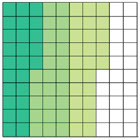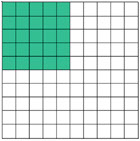
The 100's Grid
• The Hundreds Grid Investigation gives students an opportunity to explore and investigate the relationships between fractions and the base ten system.
• Students are asked to represent benchmark fractions by shading them in on a hundreds grid and writing the corresponding equivalent fractions (i.e., ½ = 50/100).
• Students have most likely used hundreds grids in the past when learning whole numbers, working with base ten blocks, or even looking for patterns in the grid.
• The grid allows an easy transfer to decimals and percents because it situates fractions in the base ten system.
• Students who need more support benefit from the structure of this representation, allowing them to count squares or bars with the grid.
Anticipating
This involves the teacher anticipating a number of things that might occur during the lesson, such as thinking ahead to what students might do correctly as well as areas of struggle. The goal is not to provide students with answers or procedures, but enough support for students to engage in the mathematics inherent in the task. Thinking ahead to how you will navigate through the lesson, such as supporting students who struggle with concepts, is an important consideration in this phase.
Resources: The Hundreds Grid Lesson Plan; Hundreds Grids
Part 1
The second part of anticipating involves engaging students in the investigation. You will plan ahead of time how you might help students move forward who are having a hard time getting started with the problem or challenging students who seem to find the investigation easy.
Considerations for this CDT:
• Question you might use for the monitoring phase should be anticipated based upon your thinking through the possible strategies and misconceptions. Possible questions include: Why did you choose to shade the hundreds grid in that way? Questions like these can be found in the question ideas resource.
• You will want to sequence the fractions for the investigation intentionally, starting with ½ and ending with fractions such as 1/3 and 1/8 (those that move beyond shading in whole squares).
• You will want to anticipate strategies for supporting the variety of students in your class. Questions asking students to identify patterns in the grid can help students who are having a hard time getting started. For students who find the task easy, you can anticipate extensions, such as asking them to provide multiple shadings for each fraction with the goal of choosing a representation that makes it easiest to write decimals and percents from the grid.
Part 2
During anticipating, you want to plan for possible solutions students may come up with in relation to a task. The Thinking Through a Lesson Protocol (TTLP) will help guide you in this activity with questions to think more deeply about when implementing a task. You will want to think about possible solutions students might have, methods they may use, misconceptions they may have, and also errors they might make. You can do this by brainstorming possible student approaches and devise strategies for misconceptions ahead of time.
Considerations for this CDT:
• Even though the hundreds grid is a popular representation used in mathematics, students may not have experience using a blank hundreds grid. Students may attempt to count each square when shading and this strategy is highly ineffective.
• Students will most likely have many strategies for shading in the hundreds grid (i.e., 10 squares at a time – a bar, shade in on the diagonal, etc.). These are all appropriate strategies for shading, although some will be easier to “count” than others.
• When writing the equivalent fractions for the shaded part, students may not understand the shaded amount refers to the numerator and the entire grid (100) refers to the denominator of the fraction.
• A common misconception when shading fractions is that half squares cannot be shaded. Yet, it is necessary when exploring fractions such as 1/8.
• Additionally, fractions such as 1/3 and 1/6 are quite challenging and students will not necessarily know how to continuously cut a square into thirds repeatedly. However, this is a great opportunity to explore the notion of 1/3 as a repeating “decimal”.


Monitoring
The goal of monitoring is to learn more about students’ ways and means of operating. You will likely have a variety of student responses and your goal is to challenge each student appropriately. Questions are used to help you address this goal. Monitoring is not about giving correct answers, procedures, or solutions. In order to push students thinking, you need to ask students questions, listen to their thinking, and find ways to extend their thinking.
Considerations for this CDT:
• You will use the questions you anticipated previously, or ones from the question guide as you monitor students thinking in this part of the lesson.
• When monitoring, look for a variety of shading strategies. You will want to use this time to be thinking ahead to the next phase where students share their strategies with each other.
• For students who need more support, allow them more time to work with simple fractions, such as ½ and ¼. Help them make connections between these two fractions, asking questions about their shadings.
• For students who find the task easy, feed them more fractions to shade or ask them to think about additional equivalent fractions they can make using their grid. They can even pose fractions to a classmate to challenge each other.
Resource: Hundreds Grid Question Ideas
Connecting
The goal of connecting is to have students present their work to others to foster mathematical connections among students. You use the information gained from the monitoring phase to help guide this part of the lesson. You will want to know the various ways students are thinking before calling on them to share. Students can use the sharing time to explain struggles they overcame and their transition from concrete to more abstract ways of representing problems. The main outcome from this sharing should be focused on exposing students to various ways the investigation can be addressed, regardless of their current level of operating.
Considerations for this CDT…
• To allow all students an opportunity to share their thinking, you may want to ask students who struggled to share their strategies first, then move to more advanced representations.
• In relation to the fraction 1/3, it will be important to have students share their various ways of shading in a fraction like this. Ask students how they decided that the fraction should be .33333 and how they know it keeps repeating.
• Have students share some fractions that weren’t shaded in by the class.
• Try to be intentional when having students share the related equivalent fractions, asking them how they knew for example, that 50/100 is the same as 25/50 and ½.